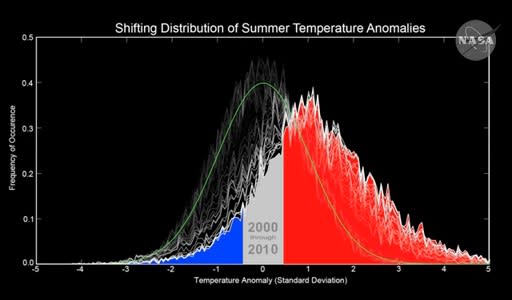 Daily Brew
Daily BrewCanadians believe climate change is occurring as July 2012 becomes hottest month on record
On the heels of reports that July 2012 was the hottest month ever recorded, a recent survey found that out of over 1500 Canadian respondents, only 2% did not believe that climate change was real. The numbers aren't quite so high in the United States, but just last year a poll found that the number of people there that believe that climate change is real was 62%, up from 58% in 2010. That's still promising.
I've been a meteorologist and air quality scientist for the last 12 years, so I knew the science behind the issue, but I'll admit I was a global warming/climate change skeptic. As a scientist, I believe that skepticism is a good thing. It makes us look for more evidence, and more evidence leads to a better understanding of the world.
However, I didn't outright deny that climate change was happening. The facts were there that the average global temperature was on the rise. I just wasn't convinced that it was solely due to human activity.
It took a lot of research on my part, and a lot of sifting through bad science, misinformation, and biased reports to get there, but I'm no longer a skeptic.
[ Related: What country faces the worst climate change? ]
Others have gone through the same thing, but in a bit more public and ironic ways. Richard Muller was contracted by the Koch Brothers, the biggest funding source for climate change denial in the United States, to establish the Berkeley Earth Surface Temperatures study. Rather than provide the brothers with evidence that they could use to fuel climate change denial, Richard ended up switching sides. BEST showed that the increases in concentration of carbon dioxide in the atmosphere showed the closest correlation to the temperature increases on record.
In another study that was recently released, Dr. James Hansen, the head of NASA's Goddard Institute for Space Studies in New York City, and the man who was the first to start talking about a warming climate back in the '80s, linked an increase in extreme weather events to global warming. He plotted 60 years worth of extreme summer temperature anomalies, when the temperature was hotter than usual and when the temperature was cooler than usual. From 1950 to 1980, the graph shows a fairly normal distribution or 'bell-curve' result. From 1981 on, though, the distribution begins to shift towards more warmer anomalies than cooler, and by 2010 you have this:
That's a pretty dramatic shift.
Now, Hansen points out that this doesn't mean that every year from now on will be hotter than the last, and there won't always be more droughts, but that is the way the trend is going.
[ Related: Climate change could make some parasites deadlier ]
(Graph courtesy of NASA)



